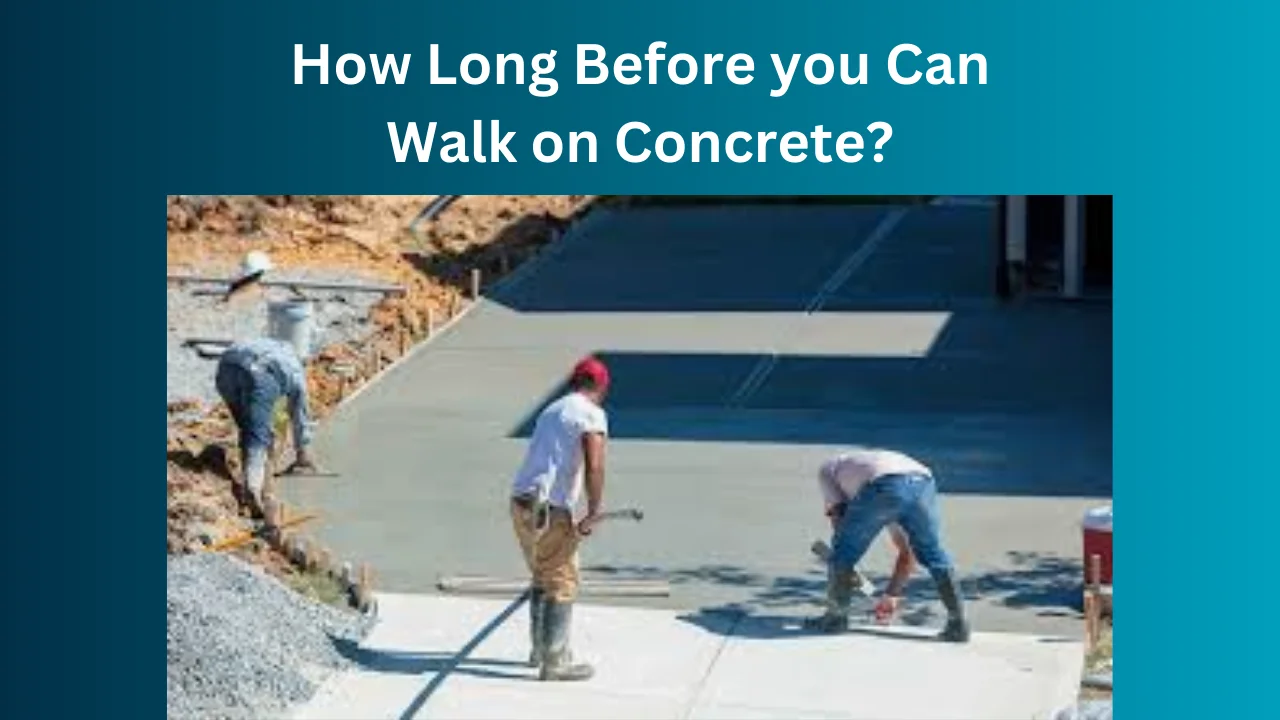Introduction
The adaptability and longevity of concrete have made it a popular building material. If you want your newly laid concrete sidewalk, patio, or driveway to last as long as possible and look great for years to come, you must know how long it is safe to walk on the surface after it has been poured. How Long Before You Can Walk on Concrete? If you’re a builder, you’ll find this article very useful as it delves into the variables that affect how long it takes for concrete to dry and cure.
Purpose of the Article
Anyone looking for information about when it is safe to walk on freshly poured concrete, whether they are homeowners, do-it-yourself enthusiasts, or construction workers, will find it in this article. This article strives to instill confidence and enthusiasm in your ability to safely complete concrete projects by offering expert insights and well-established guidelines.
Factors Affecting Concrete Drying Time
Type of Concrete Mix
Drying and curing times for concrete can vary greatly depending on the mix. The drying process is greatly affected by the mix’s composition, which includes the cement, water, and aggregates ratio. For example, a mixture that contains more water will take more time to dry than one that contains less water. On top of that, concrete with a quick-drying mix can be prepared for foot traffic considerably earlier.
Environmental Conditions
The rate at which concrete dries is very sensitive to atmospheric conditions like temperature, humidity, and wind speed. Too much heat and dryness can cause concrete to dry too rapidly, which in turn can cause surface imperfections and cracks. On the flip side, when it’s cold and humid, drying can be a lot slower, so you’ll need more time before you can use the surface safely.
Purpose of the Concrete Surface
The recommended amount of time to wait before allowing foot traffic on concrete surfaces is also dependent on their intended use. A commercial driveway designed to support heavier loads may necessitate a longer curing time to attain adequate strength and durability, in contrast to a residential pavement that could be suitable for walking in as little as 24 to 48 hours.
Concrete Strength Development
Strength increases in concrete are cumulative and are most pronounced in the first 28 days. After a couple of days, the surface might be walkable, but it’s still not tough enough to withstand heavy objects or sharp collisions. To make sure the concrete doesn’t lose its structural integrity while reaching its maximum strength, it’s helpful to understand how the strength develops.
Walking on Fresh Concrete
Initial Drying Phase
For concrete to set correctly, the first drying phase is of utmost importance. It is critical to shield the surface from heavy foot activity, environmental elements like rain and heat for the first twenty-four hours. The concrete can start to harden and gain its initial strength during this time.
Protecting the Surface
You should still take precautions to avoid damaging the concrete surface after the first drying phase. Covering the concrete with plastic sheeting can protect it from bad weather conditions, and using barriers or caution tape can help prevent accidental foot traffic. These precautions guarantee that the surface will not be damaged or imperfect in any way.
Introduction of Foot Traffic
After the first two days, you can slowly begin to bring in foot traffic. While the concrete is still curing and becoming strong, it’s best to keep sharp or heavy things away from it. In most cases, light foot traffic is fine, but you should still be careful to avoid damaging the surface.
Full Curing Period
Around 28 days after mixing, concrete attains its ultimate strength. It is crucial to refrain from activities that could put stress on the surface, such as placing heavy loads, during the curing period. A smooth and long-lasting finish is achieved by keeping a close eye on the concrete and fixing any problems as soon as they arise.
Weather’s Impact on Drying Time
Hot and Dry Conditions
Concrete may develop surface problems and cracks if it loses moisture too rapidly in hot and dry weather. Curing compounds or water misting techniques can help keep moisture levels enough to minimise this. When concrete is hydrated correctly, it dries uniformly and gains the required strength.
Cold and Humid Conditions
Extremely slow drying times are possible in cold and humid environments. It is crucial to lengthen the waiting period before permitting foot traffic in such environments. To further guarantee that the concrete hardens as planned, it is possible to use heaters or concrete blankets to keep the temperature at the ideal curing point.
Wind and Rain
Rain and wind speed up or slow down the drying process of concrete. Uneven drying can occur if the top layer is washed away by rain or if strong winds cause evaporation, which can cause surface cracks. The curing process of concrete can be facilitated by erecting windbreaks or temporary shelters to keep the elements out.
Ideal Conditions for Concrete to Dry
Optimal Temperature Range
Between ten and twenty-one degrees Celsius, or fifty degrees Fahrenheit, is the sweet spot for concrete drying. If the temperature stays within this range, the concrete will harden evenly and not lose moisture too quickly or too slowly. Optimal drying conditions can be maintained by keeping an eye on the temperature and modifying protective measures as needed.
Maintaining Adequate Moisture
For concrete to cure properly, it is essential to keep the moisture level just right. To keep the surface from drying out too rapidly, you can use curing compounds, water misting, or wet coverings to retain moisture. For concrete to achieve its strength and durability goals, it must be hydrated correctly.
Avoiding Extreme Conditions
The drying process can be considerably impacted by extremely cold or extremely hot weather. Postponing the concrete pour or adding extra safety precautions is the best course of action in such situations. For optimal drying results, it is important to maintain a stable and controlled environment.
Concrete Surface Susceptibility
Risk of Cracks and Imperfections
Cracks and surface imperfections are more likely to appear in freshly mixed concrete when it is first drying. Some of the factors that can lead to these problems include quick drying out, stress from the environment, or using the wrong curing methods. For a perfect result, it’s important to take precautions and follow the instructions to the letter.
Heavy Loads and Sharp Impacts
Recent concrete pours are vulnerable to severe damage from heavy objects and hard collisions. Be careful not to put any weight on the surface or do anything else that could cause it stress until it has cured completely. Concrete maintains its integrity and lifespan when protected from such stresses.
Monitoring and Maintenance
For the desired results, it is essential to regularly monitor and maintain the curing period. You can catch cracks, discoloration, or uneven drying early on and fix them before they become worse. Keeping the concrete in top shape for its entire lifespan is possible with the help of regular maintenance procedures.
Waiting Period Before Usage
Light Foot Traffic
In most cases, after 24 to 48 hours, concrete can typically be lightly trodden. Be careful not to harm the surface with sharp objects or shoes with a lot of tread. To avoid wear and stress, it is best to introduce foot traffic slowly while being careful.
Heavy Foot Traffic and Loads
It is recommended to wait at least 7 days before permitting usage in areas with heavy foot traffic or loads. The concrete must have strengthened enough to endure the additional stress, which is why the waiting period is so long. If you want your surface to last as long as possible, follow these steps.
Complete Curing Period
It takes about 28 days for concrete to cure completely. During this time, you must not do anything that could damage the surface, especially not lift heavy objects. The concrete will reach its maximum potential and produce a long-lasting, durable finish if you are patient during this phase.
Precautions and Best Practices
Using Protective Barriers
During the initial drying phase, it is helpful to use protective barriers, such as caution tape or barriers, to avoid unintentional foot traffic. As a visual deterrent, these measures keep the concrete in its original, undamaged state.
Covering the Surface
To shield the concrete from bad weather, you can cover it with plastic or curing blankets. The concrete will cure uniformly and reach its strength goals if these coverings are used because they retain moisture and slow drying.
Avoiding Heavy Equipment
While concrete is curing, it is very important not to use heavy machinery or do any construction on top of it. When surfaces are subjected to stress and damage from heavy loads, their integrity can be compromised. To get a finish that will last, wait until the concrete cures completely.
Concrete Mix and Curing Time
Standard Concrete Mix
The three main ingredients in concrete are water, aggregates (like sand or gravel), and cement. Common uses for this mixture include driveways, patios and pavements in residential areas. In as little as 24 to 48 hours, under ideal drying conditions, a regular mix can be prepared for light foot traffic.
Rapid-Drying Concrete Mix
In order to hasten the drying and curing of concrete, manufacturers have developed rapid-drying concrete mixes. The additives in these mixes speed up the drying process, making them more practical in a shorter amount of time. But for the best results, always apply and cure according to the manufacturer’s instructions.
Customized Concrete Mixes
The drying time and strength development of a concrete mix can be adjusted to suit the needs of a particular project. For the best results and longest lifespan, it’s recommended to consult a concrete expert or supplier when deciding on a mix.
Understanding Concrete Curing
Hydration Process
Cement and water undergo a chemical reaction known as the hydration process as concrete cures. The strength and longevity of concrete are derived from the bonds formed by this reaction. The concrete can only reach its maximum strength when the moisture level is kept constant throughout the hydration process.
Strength Development
The strength of concrete increases with time, with the first 28 days seeing the most rapid increase. Setting and developing early strength occurs during the first 24 to 48 hours, while overall strength and durability are built up during the following days. Determining the appropriate waiting period for usage requires an understanding of the strength development process.
Curing Compounds and Techniques
To regulate the drying process and keep moisture in, curing compounds and methods are employed. To keep the right amount of moisture and slow down the drying process, you can use curing compounds or wet coverings like plastic sheeting or hessian. By following these steps, you can be sure that your concrete will cure uniformly and reach its strength target.
Frequently Asked Questions
What is the minimum drying time for concrete before walking on it?
The minimum drying time for concrete before walking on it is generally 24 to 48 hours. However, this can vary based on environmental conditions, concrete mix, and project requirements. It is important to follow guidelines and monitor the surface to ensure it is ready for foot traffic.
How does weather affect the curing time of concrete?
Weather conditions such as temperature, humidity, wind, and rain significantly impact the curing time of concrete. Hot and dry conditions can accelerate moisture loss, while cold and humid conditions can prolong the drying process. Implementing protective measures and adjusting for weather conditions helps achieve optimal results.
Can I walk on concrete after 24 hours of pouring?
In most cases, you can walk on concrete after 24 hours of pouring. However, it is essential to avoid heavy loads or sharp objects that could damage the surface. Gradually introducing foot traffic and exercising caution ensures the concrete remains intact and continues to cure properly.
What factors influence the time it takes for concrete to dry enough for foot traffic?
Several factors influence the time it takes for concrete to dry enough for foot traffic, including the type of concrete mix, environmental conditions, and the purpose of the surface. Understanding these factors and following guidelines helps determine the appropriate waiting period for safe usage.
Is it safe to walk on concrete that is still curing?
While it is generally safe to walk on concrete that is still curing after 24 to 48 hours, it is important to exercise caution. The surface is still developing strength and can be susceptible to damage from heavy loads or sharp impacts. Following proper guidelines and monitoring the curing process ensures the concrete remains durable and long-lasting.
Conclusion
To ensure the surface’s durability and longevity, it is crucial to know “How Long Before You Can Walk on Concrete?” You can determine how long pedestrians should wait before walking on a concrete surface by considering factors like the mix type, the weather, and the surface’s intended use. If you want your concrete to dry and cure to a smooth, durable, and long-lasting finish, it’s important to follow the instructions and take precautions.

Shannon Reyes is a seasoned writer with a knack for crafting engaging blogs on a variety of service industries, including plumbing, cleansing, moving, pest control, and roofing. With a keen eye for detail and a passion for helping readers navigate complex topics, Shannon brings her expertise to life through informative and accessible content.










